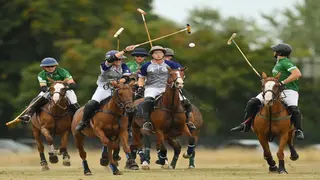The top 15 best boxing anime and manga to watch right now
Boxing
Taekwondo, an ancient Korean martial art, is a way to defend oneself and a path to empowerment and self-discipline. The taekwondo belts system, which denotes the practitioner's competence and proficiency, is essential to the evolution of taekwondo learning. Each coloured belt, from the lowly white of a beginner to the renowned black of a master, signifies a significant step in the practitioner's progress toward mastering the discipline.

Although modern Taekwondo started in South Korea, the belt division and grading system has existed for ages. The current concept of the grading system has been adapted from different martial arts such as Judo, Kung Fu, karate, and boxing. So, what do Taekwondo belts mean, and how many Taekwondo belts are there?
The great martial arts legend Kano Jigoro was a genius who developed Judo. He arranged and formulated today's grading system to establish proficiency levels that would divide pupils according to their skills.
The top 15 best boxing anime and manga to watch right now
Boxing
According to various online sources, here are the Taekwondo belts in order from the lowest to the highest level.
It represents a beginner's position, a clean slate, and the start of their journey. It stands for innocence, receptivity to learning, and purity.

Students are introduced to Taekwondo core movements and forms in this phase, emphasizing improving balance, coordination, and self-control.
In the list of all Taekwondo belts, the yellow one comes fifth. It represents the practitioner's development and movement forward along their path of achieving proficiency.
Although it adds to the white belt's foundation by introducing more complex techniques and broadening the practitioner's knowledge, it also lays the foundation for subsequent growth as they develop confidence and skill.
It is a rank that denotes continued development and progress. It indicates a greater comprehension of methods, forms, and sparring tactics and builds on the groundwork of earlier ranks.
Which are the best Puma basketball shoes in the history of the game? A ranked list
NBA
The practitioner gains a better sense of discipline and attention as a green rank level and continues to improve their skills and get more physically fit. It acts as a springboard for more advanced Taekwondo proficiency.
It is an advanced rank in Taekwondo, symbolises outstanding achievement and skill growth. A practitioner with a brown one has high technical mastery, stamina, and devotion to martial arts.
They explore the nuances of advanced forms, techniques, and sparring drills. The brown one emphasizes the value of self-control, patience, and ongoing growth as it prepares practitioners for the highest rank.
It indicates a high degree of proficiency and dedication and is an important achievement in Taekwondo. The practitioners refine their techniques to hone their physical and mental skills.
At this stage, emphasis is placed on advanced forms and self-defence methods, preparing the students for the last phases of their training to earn the highest rank.
The 15 best tennis anime and manga to watch right now
Tennis
They represent the practitioner's dedication to lifelong learning and act as a stepping stone to greater levels of taekwondo belts competence.

The black belt is the highest level of proficiency and represents the martial art's mastery. Years of committed practice, self-control, and persistence are necessary to earn the black one.
It denotes the practitioner's in-depth knowledge of complex moves, forms, self-defence techniques, and sparring tactics. The highest rank represents respect, honesty, unwavering spirit, and physical prowess.
The practitioner will now enter a new stage of their journey as they continue to expand their knowledge and pursue growth and improvement.
Different levels are denoted by various stripes, which are short coloured tape strips that serve as a way to chart advancement and honour successes.
The stripes are generally sewn onto them and are a visible indicator of the practitioner's advancement within their current level. Several criteria, such as technical competence, knowledge, attitude, and attendance, give out stripes.
Who are the most famous mountain climbers in the world right now?
Other Sports

They give practitioners more incentive and support to pursue excellence and continue their education. Each institution or group may have unique standards and procedures for awarding according to stripes.
It indicates a high level of experience and proficiency in the martial art. It is the product of many years of diligent practice, discipline, and technical and formal proficiency.
The highest level is the 9th Dan. However, it's uncommon for someone to get that far—the greater knowledge, accountability, and dedication to the Taekwondo art that each Dan level signifies.
An athlete with the highest level cannot be lost since it represents experience level and time invested in learning the martial art. Unlike UFC title ones, it can't be taken away from you for behaviour outside the gym.
Who are the most famous horse polo players ever? A list of the top 10 horse polo players
Other Sports
According to several experts in the field, it takes three to five years to master the art of Taekwondo and get the highest rank.
Becoming a master in the sport is no easy task since it requires a lot of commitment, determination, and progress. It can take up to 20 years to be considered a master.

Over the years, the purple colour has gained some recognition and is used to instruct qualified lower-ranked students. In some cases, black and purple are considered to be on the same level.
Different parts of the world recognize their instructors by various names according to the levels that they are in charge of. Those teachers that hold first and third are called Boosabum, those from fourth to sixth are known as Sabum, those from seventh to eighth are called Sahyun, and those in the ninth are known as Saseong.
Kung Fu belts ranking system: How many belts are there in Kung Fu?
MMA
The sport has several benefits, such as increasing the body's stamina, increased confidence, incredible concentration, great flexibility, enhanced cognitive abilities, and improved muscle toning.
Years of committed practice, self-control, and persistence are necessary for individuals to level up and obtain Taekwondo belts. However, it is crucial to understand that the black belt is not the end of the journey but rather the beginning of a new stage. The highest level represents the practitioner's dedication to lifelong development and advancement in Taekwondo. Additionally, it exemplifies the qualities of respect, integrity, and indomitable spirit.
READ ALSO: 10 richest African footballers in 2023 and their net worth
Sports Brief recently compiled a list of the top ten richest African footballers and their net worth. Most of these rich African footballers play for the world's biggest clubs and pocket massive amounts weekly as salaries. Some of the best players, like Liverpool's Mohamed Salah, are among the wealthiest players in Africa.
Other streams of income for footballers, including brand endorsements and investments, add to these players' net worth apart from their salaries. Click on the link above for more details about the ten richest African footballers.